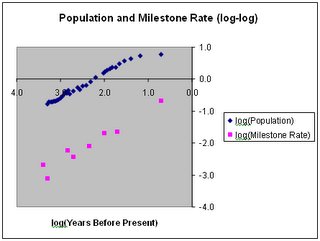 Ray Kurzweil argues that human technology is accelerating exponentially in part by referring to data which shows the shrinking time interval between “paradigm shifts”. He ascribes this acceleration to cumulative complexity feeding on itself. (The Singularity Is Near: When Humans Transcend Biology, Ch. 1, p18 ff). There’s a scan of the Kurzweil chart in Kevin Drum’s blog post. It’s worth reading, if only for Kurzweil’s admission in a reply post that this past acceleration does not imply that there will be continued acceleration in the future.
Ray Kurzweil argues that human technology is accelerating exponentially in part by referring to data which shows the shrinking time interval between “paradigm shifts”. He ascribes this acceleration to cumulative complexity feeding on itself. (The Singularity Is Near: When Humans Transcend Biology, Ch. 1, p18 ff). There’s a scan of the Kurzweil chart in Kevin Drum’s blog post. It’s worth reading, if only for Kurzweil’s admission in a reply post that this past acceleration does not imply that there will be continued acceleration in the future. There’s a simpler explanation, however: the exponential acceleration of paradigm shifts can be entirely accounted for by the exponential growth in human population. More people, more brains; more brains, more frequent shifts.
Kurzweil builds on data Theodore Modis collected on the growth of complexity and change. Modis lists “canonical milestones” in the history of the universe. (The Canonical Milestones in the chart on p20 of Kurzweil don’t correspond exactly to the list in Modis’s paper; I’ve used the dates in Modis.) To facilitate comparison with population growth, I use the rate at which the milestones occur rather than Kurzweil’s “Time to Next Event” parameter. The one is the inverse of the other; as one gets closer to the present, the Time To Next Event shrinks, which means that the rate grows.
In my analysis (see spreadsheet for detailed workings and the source data), I plotted the occurrence rate for the “canonical milestones” and against human population growth on the same log-log chart; see graphic above.
The result is uncanny: to within the errors of this very squishy data, the two lines have the same slope. That means that the ratio between the rate of milestone occurrence and human population is constant, at roughly two milestones per century per billion people over the last two thousand years. If one makes the jump from correlation to causation, the driving force is simple: More people means more innovation.
Occam’s Razor applies here. If one can explain the growth in the breakthrough rate by invoking increasing population, and without invoking some mystical acceleration of order and complexity, one should do so. An increase in complexity is a consequence of increased innovation, but it’s not obvious that’s it’s the only cause.
Kurzweil points out in Kevin Drum’s blog that one shouldn’t extrapolate a log-log curve like this one. However, we now have a model for why the data behaves this way, and we can predict that a slowing down in the population growth rate will lead to a slow-down in the shift rate. This contradicts the thrust of Kurzweil’s argument, which is that cumulative complexity will lead to an ever-faster shift rate.
Even if the ratio between paradigm shift rate can’t be completely explained by population growth, the “more brains” effect should be factored out of the data before one tries to draw conclusions about accelerating complexity.
Complexity being driven by a simple input like population suggests that other exponentials that Kurzweil observes, eg
I’ve only looked at the last two thousand years. Kurzweil and Modis make a far more radical claim: that major shifts in the entire history of the universe, from the Big Bang to the Internet, can be plotted on a single line with a constant rate of exponential growth over ten billion years. The implication is that there is a single accelerating process that underlies all phenomena – things as diverse as cosmogony and technology innovation. I find this a stretch. The data is suspiciously neat, but let’s stipulate it; the question then is: Are there other ways to explain the curve?
I suspect that the underlying reason is the selection process; humans consider exponentially fewer and fewer things to be interesting as they look back in time from the present moment. We believe that our vantage point is privileged. Ptolemaic astronomy put the Earth at the center of the universe. When we put our moment in history at the center, I call it the Special Present Fallacy. More on this in a future post.